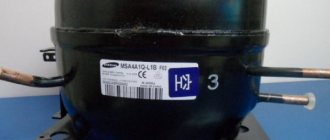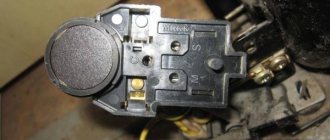One of the most common problems with refrigerators is the formation of ice on the walls. It causes food to freeze and causes leaks. You should not ignore this situation, trying to get rid of ice, beating it off or periodically defrosting the equipment. This will not fix the problem, since freezing always indicates some kind of failure. Therefore, you need to understand why ice freezes on the back wall of the refrigerator, how to avoid it, and what to do if this problem occurs.
Ice on the back wall
We determine the disease by symptoms
The refrigerator must be inspected by a specialist. But you can determine some reasons yourself. For your convenience, we provide a table of the most common breakdowns and malfunctions of the refrigerator and their symptoms. From it you can roughly determine what happened to the unit.
Important
In inverter refrigerators, the motor (compressor) does not turn off. It works constantly, but at different speeds (performance, power, intensity). In conventional ones, the compressor turns on and off periodically. Read more about the differences between inverter compressors and conventional ones in this article.
| Signs | Causes |
| Ice slowly forms over the entire surface of the rear wall, the compressor turns on more often than usual or works more intensely. | The seal of the chamber is broken, the temperature sensor or thermostat is out of order, the wrong type of freon is charged, the drainage is clogged, incorrect settings and operating modes, problems with the magnetic valve. |
| The entire back wall is frozen, the compressor works as usual. | They filled with a different freon, the seal is broken, the airflow does not work (No Frost), the refrigerator is overloaded with food, food is stored in open containers, the drainage is clogged. |
| Ice forms on part of the rear wall, the compressor is operating normally. | One of the fans does not work or the air duct is clogged (No Frost), the compartment or shelf is completely loaded with products, there is a refrigerant leak, the freon line is clogged. |
| Ice or snow freezes on part of the rear wall, the compressor works harder than usual or turns on more often. | There is a blockage or sediment in the copper capillary tubes with refrigerant, a freon leak, part of the thermal insulation of the wall is wet and iced. |
Defrosting when ice appears in the refrigerator
Owners of modern refrigerators with a no-frost system note that the defrosting procedure on some models has to be done quite often. To ensure that this procedure does not lead to breakdown of the technical device, it should be carried out correctly:
- The first thing to start with is disconnecting the refrigeration unit from the power source. That is, remove the plug from the socket.
- The resulting ice may make you want to remove it mechanically: cut it off with a knife or scrape it off with any other hard object. Under no circumstances should this be done.
- The wall thickness of the heat exchanger is small. It will not be difficult to cause damage to it by mechanical force. As a result, the problem will develop into a completely different direction. You will have to contact the service department for repairs, which will not be cheap.
- The defrosting process can be accelerated by using a container of warm water. The use of boiling water is excluded. If the water temperature is close to 100 degrees, its impact on the surfaces of the refrigerator can lead to damage. It is recommended to install the container on a woven material or on a board. To quickly dry it, you can use a hairdryer, but first you need to make sure that the heating function is not turned on.
- Some refrigerator users are afraid that defrosting them may cause damage. In this situation, you can entrust the procedure to the technical device itself. After the defrosting process is completed, the person will only need to remove excess moisture.
- Next, you need to wait a while (about half an hour) before returning the products to their places. This is necessary for the refrigerator to return to standard operation. This is most relevant in the warm season.
Remember! Refrigerators with “NoFrost” require defrosting only when there are any malfunctions. The main advantage that was pursued when developing the operating process of the system is the absence of the need for defrosting, due to the removal of moisture by the technical device itself.
Violation of tightness
The back wall of the refrigerator freezes due to high humidity. As ice forms, the air in the chamber dries out and ice does not form. If the chamber is not sealed and there is an influx of air from outside, ice and snow will constantly build up. In addition, this is one of the reasons for the accumulation of water under the boxes for vegetables and fruits.
Due to the influx of heat from outside, the compressor turns on more often or operates at an increased speed (if you have an inverter refrigerator). The evaporator temperature drops below standard, which leads to freezing of the walls.
There are three reasons why air gets into the refrigerator:
- Worn seals;
- The sash does not close completely;
- Mechanical damage to the body and panels.
You can determine the cause of chamber depressurization by eye. After this, make a decision - call a specialist, or fix the problem yourself.
Important
Tip: If the original seal in the service center is expensive, you can use a universal one. The main criterion when choosing is its height. When unclamped, it should be 2-4 mm larger than the gap between the sash and the body.
Frequent breakdowns
Ice inside occurs when the seals of the chambers are broken, the drainage channel is clogged, refrigerant leaks, failure of electronic components and “stuck” sensors.
Insulation frozen
The body of the refrigeration cabinet is equipped with a heat-insulating layer.
If used incorrectly or due to manufacturing defects, condensation will form in the walls. Moistened thermal insulation freezes and ice appears outside.
Damaged areas of the protective layer are removed, replacing them with new material.
Seal wear
The seal has deteriorated.
The rubber door gasket protects the chambers from the penetration of warm air. Over time, the seal loses its functions, becomes deformed, hardens or wears out. Because under the influence of oxygen and temperature changes, rubber loosens.
If you open the refrigerator carelessly, the gasket is damaged. Wear of the seal of a Samsung, Indesit or Ariston refrigerator is accompanied by an increase in the internal temperature of the chamber. To cool the air, the compressor starts working without stopping.
The condenser (evaporator) is overcooled, the ice does not have time to thaw and drain into the container.
Repair process:
- External signs of malfunction: When the rubber band wears out, the back wall is completely covered with ice. Frozen drops are found below. The motor turns off for no more than 10 minutes, constantly hums and overheats.
- Inspect the seal. When palpated, dents, cracks and holes are felt. There is a gap between the door and the body when closing.
- Replace with a new one. You can purchase the required part from a service center and install it yourself. If possible, we recommend temporarily restoring the old seal yourself. To do this, soak the rubber band in boiling water for 5-10 minutes, then apply sealant (acrylic or silicone) and seal the cracks.
Read more about replacing the seal yourself in this article.
Clogged capillary line
Repair of capillary pipeline.
Blockage (due to the formation of blood clots from settling oil) occurs when heated oil comes into contact with freon.
The inner diameter of the tube is only 0.5 mm, therefore, even a small clot interferes with the movement of the refrigerant, which is accompanied by overheating of the compressor due to constant operation. The result is the formation of a thick snow coat in the freezer or an increase in temperature in the refrigerator compartment.
You won't be able to fix the problem yourself. It is necessary to depressurize the system using professional equipment, pump out the exhaust gas and clean the entire cooling system.
Freon leak
If the refrigerant is lost, the device is not able to properly cool the internal space. In drip systems, leakage occurs due to corrosion caused by melt water entering the pipes. With prolonged exposure to moisture, the metal is damaged, holes and microcracks appear.
In No Frost refrigerators, pipe connections often fail. If freon leaks, the compressor operation mode becomes continuous. The temperature sensor transmits data about an increase in T, but due to physical damage, it is impossible to adequately cool the entire volume of the chamber. Ice appears in one part of the back wall. Most likely, after defrosting, the refrigerator will stop working. Soldering the tubes and filling in new refrigerant helps restore the functions of the device. The damaged evaporator is replaced with a new one; it is not possible to repair the spare part.
Thermostat failure
Refrigerator thermostat.
The sensor maintains the required temperature by starting and stopping the compressor. Electronically controlled refrigerators are equipped with air thermostats. The element determines the actual temperature in the compartments.
In mechanical refrigerators, a relay is installed, located near the evaporator. Voltage fluctuations and manufacturing defects contribute to part failure. Typical symptoms of a malfunction are:
- freezing of food in the refrigerator compartment;
- formation of an even layer of ice on the back wall;
- reducing the temperature in the refrigerator compartment;
- accumulation of water under the bottom drawers.
The relay must be removed and inspected. If signs of failure are detected, the element is replaced.
Magnetic valve failure
Single-compressor two-chamber refrigerators are equipped with a valve that ensures uniform distribution of cold air flows between the chambers. The element can open or block the channel. If the valve malfunctions, air flows of positive and negative temperatures flow into the refrigerating chamber.
The temperature in the vegetable drawers drops sharply, and frost forms on the back wall. The air in the freezer is steadily heating up. Replacing the part helps restore the functionality of the device.
If the refrigerator begins to freeze unevenly, it is disconnected from the network. After this, the food, shelves and vegetable boxes are removed. After waiting for the ice to thaw, remove excess moisture. The refrigerator is left for a day, after which it is connected to the network. If the problem does not disappear after defrosting, the valve must be replaced. You can find out how repairs are done by watching the video.
Problems after repair diagnostics, prevention
If the inside of the refrigerator is covered with ice, remember whether the following work has been done:
- Diagnostics;
- Prevention;
- Freon refill;
- Repair.
An incompetent technician could disrupt the work settings or mechanically damage important components. 99% of problems with refrigeration equipment after service work are associated with errors by the refrigeration technicians. In this case, contact the company or individual who worked on your refrigerator.
Concept of a return pipe in a refrigerator
The return pipe goes from the compressor to the inside of the refrigerator. This is part of the cooling system, it is connected to the motor pipe. In properly functioning refrigeration equipment, minor freezing of this part is allowed. However, the frost area should not be more than 10 cm, starting from the exit from the refrigeration housing.
The role of the return pipe in the unit
The return pipe plays the role of a control device in refrigeration equipment. It allows you to close the entire system of the unit, consisting of:
- motor - compressor;
- evaporator with condenser.
If it becomes covered with frost, this means that there has been a failure in the smooth operation of the system.
Kulibin's error
Some technicians charge the wrong freon for which the refrigerator system is designed. For example, instead of R-12 refrigerant, R-134a, R-600a can be used. Freons have different characteristics; when replacing them, you need to take into account the characteristics of the equipment.
Using a different refrigerant leads to incorrect operation of the system, especially in older models without an air temperature sensor. In this case, water will accumulate on the entire surface of the back wall of the refrigerator and freeze. Only a specialist can identify the problem and fix it.
No Frost and Total No Frost: circulation problems
No Frost system refrigerators have one or more fans behind the back panel. They provide cold air flow into the chamber and uniform cooling of the products. If one or more fans break down or become clogged, the back wall of the refrigerator becomes completely or partially covered with ice.
It is easy to check the functionality of the blower system. Open the refrigerator for 20-30 seconds. Bring the river to the air ducts in the rear panel. If the airflow is not felt or is weak, there is a problem with the fan. It may fail, become clogged with dirt or freeze.
You can clean the fan yourself:
- Disconnect the refrigerator from the power supply;
- Completely unload the products, dismantle the shelves and drawers;
- Wait until the ice on the back wall melts;
- Remove the plastic from the back panel;
- Turn on the refrigerator and check the operation of the fans.
Whether you call a professional or try to solve the problem yourself is up to you. We recommend cleaning the fans from dirt. If the problem is not solved, repair or replacement of fans and electrical wiring diagnostics are necessary.
Frozen fan in Samsung RF263BEAESR refrigerator with No Frost system
Conclusion and recommendations
If ice has frozen on the back wall of the refrigerator, not all users know what to do. It is not necessary to immediately call a technician; perhaps it is due to improper operation or overload. You need to first try to defrost the equipment. To do this, follow these steps:
- empty the refrigerator;
- turn it off from the network;
- open wide, leave for a day;
- at this time, periodically remove flowing water and thawed ice;
- wash internal surfaces and dry;
- turn it on, set the correct temperature;
- After 30-60 minutes, load the products.
In many cases, this is enough and no more ice will form. But if after some time ice appears again, you need to look for the cause of the problem. Most likely, you will have to call a technician to do this, who will diagnose and repair the equipment.
To avoid such problems, you need to use your refrigerator correctly. There are several recommendations from manufacturers and specialists that are important to follow:
- place only chilled products in closed containers in the chambers;
- arrange containers freely, air should circulate in the compartments;
- do not overload the freezer, do not try to freeze a lot of food at once;
- defrost equipment according to schedule, avoiding the appearance of a large coat of snow;
- The refrigerator should stand on a flat surface; space should be left between the back wall and the wall;
- periodically clean and lubricate the door seal with silicone grease; if it is worn out, it must be replaced;
- To replace failed parts, invite a technician from the service center.
Place food correctly in the refrigerator
The appearance of ice on the back wall of the refrigerator is a common problem. It can often be dealt with by defrosting and rearranging foods. But if this does not help, you definitely need to invite a specialist. The problem cannot be ignored, as it arises due to malfunctions. Without repair, the refrigerator may completely fail.
Plyushkin syndrome
A large number of products and ready-made dishes is the reason why the back wall of the refrigerator is covered with ice. There should be enough space in the chamber to mix cold and warm air.
If there is not enough convection, the back wall at the bottom will become very cold. Moisture will condense on it and freeze. This mainly applies to refrigerators with a drip system. Household appliances with No Frost technology are less susceptible to the risk of ice forming due to lack of free space.
When the refrigerator is so full of food, air circulation is out of the question.
Store food correctly
Ready meals in open containers are a source of moisture and heat. Because of them, snow and ice form on the wall of the refrigerator. The icing principle is as follows:
- Moisture evaporates from the surface of warm foods;
- It condenses in the form of droplets on the back wall of the chamber;
- To cool warm food faster, the refrigerator compressor starts working faster;
- The evaporator and rear wall are cooled below 0 °C;
- Drops of water turn into snow and ice.
To avoid the formation of snow and ice in the refrigerator compartment, follow two simple rules:
- Do not put hot food in the refrigerator;
- Use closed dishes or containers to store food and prepared meals.
Storing heated foods can have harmful consequences. We wrote a separate useful article about this. We recommend reading it: “Why you can’t put hot food in the refrigerator.”
When ice on the wall is not a failure
Owners of devices with a drip defrosting system are usually familiar with the problem of ice freezing on the back wall of the refrigerator compartment. Their peculiarity is that the cooled air condenses on the evaporator and flows down the walls in droplets. Sometimes they freeze, but there shouldn't be a layer of ice that doesn't melt.
If the wall is covered with ice or a coat of snow freezes, it means that some kind of malfunction has occurred or the operating rules of the equipment have been violated. This does not always indicate a serious breakdown, so you don’t have to call a specialist right away, but try to deal with the problem yourself. This is possible if the refrigerator is working normally, does not leak, or makes strange sounds.
Important!
In No Frost models, ice does not form in the refrigerator compartment; ice appears in the freezer.
Violation of operation
The most common cause of ice formation is improper operation of refrigeration equipment. The following actions can cause the problem:
- Food or dishes that have not cooled to room temperature are placed inside;
- open containers with liquids are placed;
- the freezer is overloaded with food;
- the door opens frequently and remains open for a long time;
- the back wall touches the wall, causing the motor to overheat;
- the room is too hot or there are heating devices near the appliance.
At the same time, a lot of moisture appears inside, which condenses on the evaporator and the rear wall. It can freeze, but must thaw periodically. But if there is a lot of ice, it does not have time to defrost.
Do not place food that has not cooled to room temperature.
Incorrect temperature
Sometimes users set the temperature to a very low temperature. Strong cooling causes ice to form on the walls and shelves, and food in the refrigerator compartment becomes frozen. If this happens, you need to check the settings and increase the temperature if necessary.
Important!
Manufacturers recommend abandoning the super-freezing mode in hot weather, as this puts a strain on the motor.
Loss of tightness
If warm air gets in, the thermostat will make the motor work harder. It freezes harder to maintain the desired temperature. Therefore, the drops flowing down the back wall do not have time to defrost. This happens if the door does not close tightly.
Perhaps the vegetable drawer or improperly placed dishes are in the way. But more often this happens due to damage to the seal on the door. To avoid this, it is recommended to periodically inspect it, clean it of crumbs and lubricate it with silicone grease.
Loss of tightness
Incorrect position
On some models with a drip defrost system, the drainage hole is located under the vegetable drawers. The tilt of the bottom of the camera can be small, up to 5 degrees (for example, in older Samsung models). If the refrigerator is not positioned correctly and tilted forward (towards the door), water will not drain into the drain.
The solution to the problem is to twist the legs of the refrigerator so that it takes a strictly vertical position. Or put something under them and level the unit if the rollers or legs are not adjustable.
Clogged drain
A coat of snow and ice may freeze on the back wall of the refrigerator due to a clogged drainage hole. This mainly applies to drip-type systems. In No Frost refrigerators, the drain is located behind the wall and is less likely to become clogged. If there is water under the vegetable boxes, the drainage system is clogged.
When the drainage becomes clogged, water stagnates in the tube and tray, or leaves very slowly. The humidity in the chamber increases and condensation forms on the wall. If there is a lot of it, the back wall of the refrigerator becomes covered with ice. If there is not enough - frost and snow.
Video: How to clean the drainage in the refrigerator (method No. 1)
//vteple.xyz/wp-content/uploads/2019/09/kak-prochistit-sliv-v-holodilnike-s-pomoshhju-sprincovki.mp4
Video: How to clean the drain in the refrigerator (method No. 2)
//vteple.xyz/wp-content/uploads/2019/09/kak-pochistit-drenazh-v-holodilnike.mp4
Causes of ice and snow freezing
Snow often forms in the refrigerator or freezer for reasons not related to a malfunction of the appliance. These include:
- Incorrect mode selection. Setting the intensive freezing function in the summer leads to the formation of a dense snow coat. You need to check whether the position of the regulator is set correctly. Some users believe that the harder the refrigerator freezes, the longer the freshness of the food will remain. This is not true, because turning on the intensive mode increases the load on the compressor and damages the refrigerator.
- Normal operation of the drip system. In such refrigerators, ice periodically forms and thaws on the back wall.
- Incorrect operation. Ice forms when hot foods and liquids are placed in open containers. Evaporating moisture settles on the walls. When the compressor is running, the drops freeze; while the motor is resting, the water melts and is discharged through the drainage hole. If there is a lot of condensation, the snow coat remains for a long time.
- Contamination of the defrost system. Drainage holes become clogged with food debris, mold, and dust. Regular cleaning of the refrigerator helps to avoid breakdowns. And preventative cleaning of the drainage (once a month), using a cotton swab.
- Overloading the freezer with food. If you compact the workpieces very tightly, the motor will have to work for a long time to reach a negative temperature, because of this, frost and ice may appear in the upper chamber. In this case, you don’t have to worry, as soon as the freezing cycle ends, everything will thaw.
Fur coat and plugs of the freon line
The operating principle of the refrigerator is based on cycles of condensation and evaporation of freon. It circulates in a closed system through copper tubes. During operation, foreign substances enter it:
- Microparticles of worn compressor parts;
- Refrigeration oil decomposition products;
- Clots of quickly cooled compressor oil that have entered the evaporator;
- Foreign contamination (entered during servicing of the refrigerator).
Sediments can accumulate in one place and form a plug. They can also settle on the surface of the capillary copper tubes of the evaporator.
In the first case, the compressor will work intensively, and the refrigerator will freeze snow and ice. Frost forms over the entire area, or in a separate place. This occurs due to pressure differences in the system before and after the area narrowed by contamination.
When sediment forms, the thermal conductivity of the evaporator decreases. it transfers heat worse in places where sediment accumulates. The compressor will work in intensive mode, the electricity consumption of the refrigerator will increase. The chamber will not cool evenly. A coat of snow or ice forms on part of the garden wall.
This problem cannot be fixed on your own. For repairs you need professional equipment and consumables. The specialist will have to:
- Clean the freon line;
- Clean the evaporator;
- Replace freon;
- If necessary, change the oil in the compressor.
Operating principle of the Atlant refrigerator
The functioning of a household unit is based on the physical properties of freon to release or absorb thermal energy when it transforms into a liquid and gaseous state.
The work cycle is performed in several stages:
- The compressor creates pressure in the circuit and forces hot refrigerant into the condenser.
- Passing through the condenser tubes, the freon is cooled, condensed and cleaned by a filter drier.
- The refrigerant is transported through a capillary tube of small diameter (0.5 mm) into the evaporator channels and begins to boil due to the pressure difference. The energy required to transform into a gaseous state is absorbed from the surface of the cooled evaporator.
- The cold evaporator cools the rear wall and the air in the refrigerator compartment. In units with a No Frost system, a fan forces air through cold tubes and delivers it through air ducts to the food storage compartment.
- The freon, which has turned into steam in the evaporator channels, is pumped out by the compressor and pumped back into the condenser to remove heat outside.
No Frost: Clogged air ducts
If there is little or no air circulation through one or more ducts, they may become clogged. You can check your guess by visual inspection. Debris and dirt may get trapped behind the back panel and be visible through the openings. Sometimes ice plugs form in the air vents.
You can clean them without removing the plastic covers on the back of the camera. But it is better to disassemble it and completely clean the interior space behind the back wall. To avoid problems and inconveniences, defrost the refrigerator first.
Ice in the air duct of a No Frost refrigerator
Freon leak
In normal mode, freon (refrigerant) circulates in a closed system of copper capillaries and other components. Microcracks may appear in the tubes over time. The refrigerant evaporates, its total amount in the system decreases. Refrigerator performance decreases.
When evaporating, freon reaches a certain part of the housing. A “spot” of frost, snow or ice forms on it. When there is a freon leak, ice usually freezes in the lower corners of the rear wall of the refrigerator chamber.
The problem can only be solved by calling a specialist. he will have to:
- Find the leak, solder it or replace the copper tube;
- Top up or refill the system with freon;
- Check and, if necessary, replace or add oil to the compressor.
Temperature measurement errors
In refrigerators with an electronic control system, the temperature is regulated by an air sensor. In older and budget models, the evaporator contains a thermostat (thermostatic expansion valve, expansion valve).
Failure of these system components leads to a failure of the temperature regime inside the chamber. Ice and snow are accumulating on the back wall of the refrigerator. In some cases, on the contrary, the temperature inside rises.
You can set the temperature higher or lower, but this is a temporary solution. It's better to call a specialist. He will replace or repair a faulty thermostat or air temperature sensor.
How to avoid refrigerator breakdowns in the summer heat?
To do this you need to follow a few simple steps:
Switch the cooling mode to the minimum value if the ambient temperature exceeds 25-30 degrees Celsius. Place the refrigerator away from heat sources. It is not recommended to place the refrigerator near the radiator and stove, as the device can quickly fail. The minimum distance is 1 meter, recommended – 2-3 meters. The more heat a heating device emits, the further away the refrigeration equipment should be from it. .
In America, old refrigerators are displayed along the roads. Of course, we're not talking about Harlem. Rather, this applies to small cottage towns where a fairly prosperous segment of the population lives. These refrigerators are fully functional, it’s just that the owner decided to update the set of household appliances in the house and put everything unnecessary along the highway. It is considered normal to come and pick up the item you like, or the waste disposal service will do it the next morning. This standard of living, one must think, allows Americans not to think about why the ice freezes in the refrigerator, despite the presence of the NoFrost system, but to simply get rid of this old trash.
Forgot to turn it off or set it up?
In older models and inexpensive refrigerators, the super freeze function is controlled manually. It does not turn off automatically. If ice suddenly begins to form and accumulate on the walls of your freezer, check that the SuperFrost mode is turned off.
The most common reason why the inside of a refrigerator becomes covered with ice and snow is incorrect temperature conditions. If you set the temperature in the chamber to +5 °C, then the evaporator will always be colder .
If the temperature is too low, the evaporator may cool the back wall below 0 degrees. Because of this, the back wall will freeze. The solution to the problem is simple - defrost the refrigerator and set the temperature 1 degree higher. if this does not help, repeat the procedure.
Water in isolation
A layer of ice or snow may form in a corner, at the junction of the side and back walls, or in a certain location on the back wall. The reason is the accumulation of moisture on the thermal insulation. Water accumulates on the surface of the insulating material and freezes from the evaporator.
Drops of moisture settle on the frozen area and form an ice coat. The defrosting mode does not have time to defrost the thermal insulation. Due to the low temperature, it cannot dry. The problem can only be eliminated by cutting out the damp area and replacing it with a new one.
Ice freezing in the freezer of the Indesit No Frost refrigerator
Models of the Indesit brand are characterized by a static cooling system. That is, when the compressor stops, moisture flows down the walls into the container, and the evaporator cleans it of incoming water. With the convective method of cold circulation in the chamber, no ice coating is formed.
Due to the problem of clogged drainage hose in the freezer, a layer of ice may form. Water accumulates from the walls and fills the working chamber. Ice forms in the freezer compartment. Ice on the lower chamber causes the fan to malfunction, which soon leads to a breakdown of the refrigerator.











